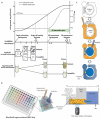Current and emerging techniques for antibiotic susceptibility tests
- PMID: 28638468
- PMCID: PMC5479269
- DOI: 10.7150/thno.19217
Current and emerging techniques for antibiotic susceptibility tests
Abstract
Infectious diseases caused by bacterial pathogens are a worldwide burden. Serious bacterial infection-related complications, such as sepsis, affect over a million people every year with mortality rates ranging from 30% to 50%. Crucial clinical microbiology laboratory responsibilities associated with patient management and treatment include isolating and identifying the causative bacterium and performing antibiotic susceptibility tests (ASTs), which are labor-intensive, complex, imprecise, and slow (taking days, depending on the growth rate of the pathogen). Considering the life-threatening condition of a septic patient and the increasing prevalence of antibiotic-resistant bacteria in hospitals, rapid and automated diagnostic tools are needed. This review summarizes the existing commercial AST methods and discusses some of the promising emerging AST tools that will empower humans to win the evolutionary war between microbial genes and human wits.
Keywords: AST methods; antibiotic susceptibility tests.
Conflict of interest statement
Competing Interests: The authors have declared that no competing interest exists.
Figures




Similar articles
-
Progress on the development of rapid methods for antimicrobial susceptibility testing.J Antimicrob Chemother. 2013 Dec;68(12):2710-7. doi: 10.1093/jac/dkt253. Epub 2013 Jun 30. J Antimicrob Chemother. 2013. PMID: 23818283 Review.
-
Rapid and Accurate Antibiotic Susceptibility Determination of tet(X)-Positive E. coli Using RNA Biomarkers.Microbiol Spectr. 2021 Oct 31;9(2):e0064821. doi: 10.1128/Spectrum.00648-21. Epub 2021 Oct 27. Microbiol Spectr. 2021. PMID: 34704829 Free PMC article.
-
A Multiplex Fluidic Chip for Rapid Phenotypic Antibiotic Susceptibility Testing.mBio. 2020 Feb 25;11(1):e03109-19. doi: 10.1128/mBio.03109-19. mBio. 2020. PMID: 32098819 Free PMC article.
-
Emerging technologies for antibiotic susceptibility testing.Biosens Bioelectron. 2019 Oct 1;142:111552. doi: 10.1016/j.bios.2019.111552. Epub 2019 Aug 9. Biosens Bioelectron. 2019. PMID: 31421358 Review.
-
Standardisation of disk diffusion results for antibiotic susceptibility testing using the sirscan automated zone reader.BMC Microbiol. 2013 Oct 8;13:225. doi: 10.1186/1471-2180-13-225. BMC Microbiol. 2013. PMID: 24099061 Free PMC article.
Cited by
-
Development of an Inverted Epifluorescence Microscope for Long-Term Monitoring of Bacteria in Multiplexed Microfluidic Devices.Sensors (Basel). 2020 Jul 25;20(15):4140. doi: 10.3390/s20154140. Sensors (Basel). 2020. PMID: 32722401 Free PMC article.
-
Dielectrophoresis assisted rapid, selective and single cell detection of antibiotic resistant bacteria with G-FETs.Biosens Bioelectron. 2020 May 15;156:112123. doi: 10.1016/j.bios.2020.112123. Epub 2020 Feb 27. Biosens Bioelectron. 2020. PMID: 32174552 Free PMC article.
-
Rapid antibiotic susceptibility testing based on bacterial motion patterns with long short-term memory neural networks.IEEE Sens J. 2020 May 1;20(9):4940-4950. doi: 10.1109/JSEN.2020.2967058. Epub 2020 Jan 17. IEEE Sens J. 2020. PMID: 32440258 Free PMC article.
-
Real-time detection of antibiotic activity by measuring nanometer-scale bacterial deformation.J Biomed Opt. 2017 Dec;22(12):1-9. doi: 10.1117/1.JBO.22.12.126002. J Biomed Opt. 2017. PMID: 29235272 Free PMC article.
-
Overcoming Antibiotic Resistance with Novel Paradigms of Antibiotic Selection.Microorganisms. 2022 Nov 30;10(12):2383. doi: 10.3390/microorganisms10122383. Microorganisms. 2022. PMID: 36557636 Free PMC article. Review.
References
-
- States U. Antibiotic resistance threats. Published Online First: 2013. http://www.cdc.gov/drugresistance/threat-report-2013/pdf/ar-threats-2013....
-
- Van Boeckel TP, Gandra S, Ashok A, Caudron Q, Grenfell BT, Levin SA. et al. Global antibiotic consumption 2000 to 2010: An analysis of national pharmaceutical sales data. Lancet Infect Dis. 2014;14:742–750. - PubMed
-
- Laxminarayan R, Duse A, Wattal C, Zaidi AKM, Wertheim HFL, Sumpradit N. et al. Antibiotic resistance — the need for global solutions. Lancet Infect Dis. 2013;3099:1057–1098. - PubMed
-
- Daniels R. Surviving the first hours in sepsis: Getting the basics right (an intensivist's perspective) J Antimicrob Chemother. 2011;66:11–23. - PubMed
Publication types
MeSH terms
Substances
LinkOut - more resources
Full Text Sources
Other Literature Sources
Medical
Miscellaneous

